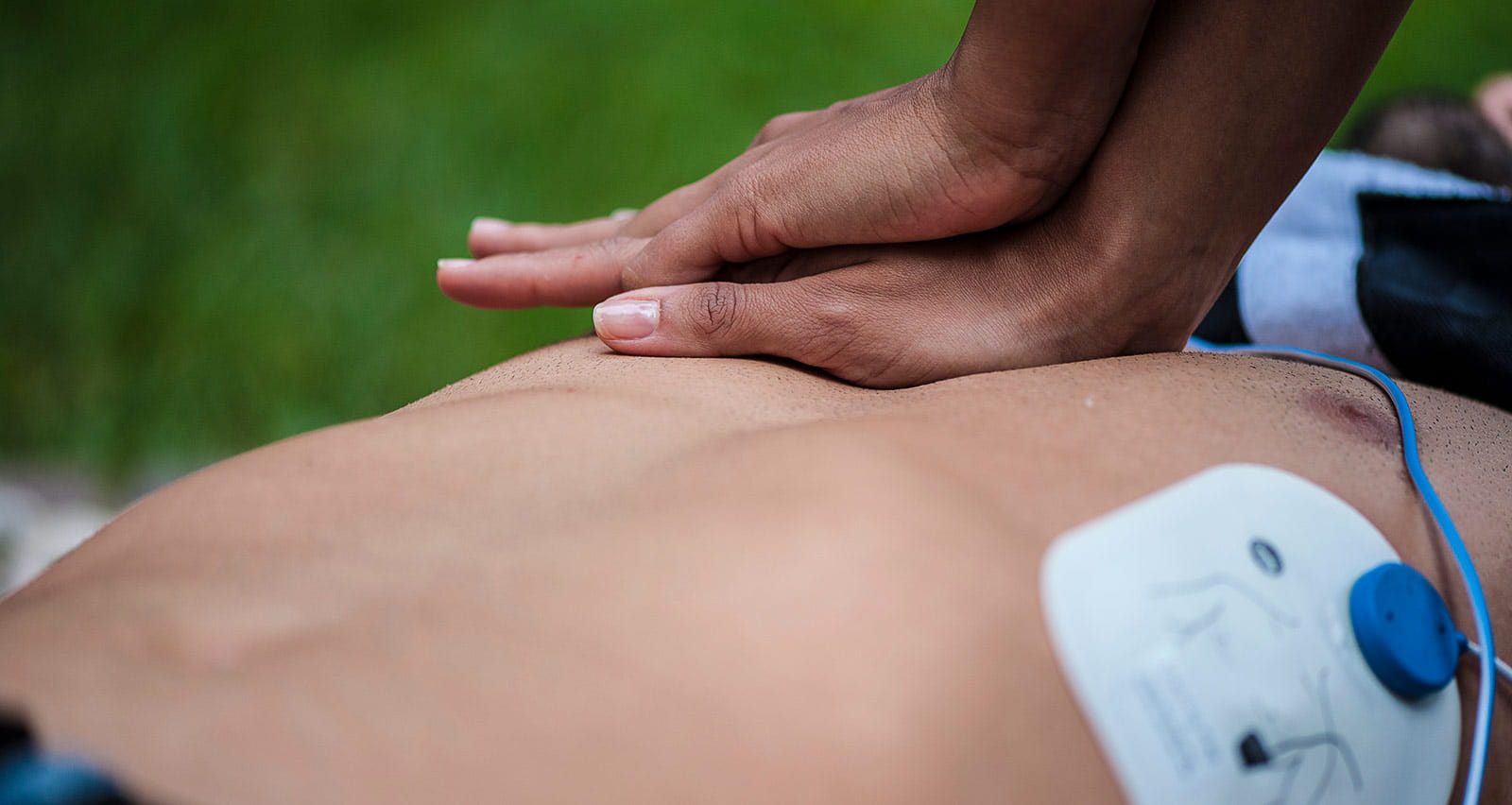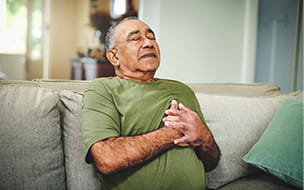
What Is Cardiac Arrest?
Cardiac arrest, also called sudden cardiac arrest (SCA), is when the heart suddenly stops beating. The lack of blood flow to the brain and other vital organs can cause loss of consciousness, permanent disability or death if not treated immediately.
Your health is important. Don’t delay care.
Offering in-person, video and telephone visits. Call 216-844-3800 today to see which option is right for you.
Schedule online with a cardiologistWhat Is the Difference Between Cardiac Arrest and a Heart Attack?
Some people think cardiac arrest and a heart attack are the same condition, but they are not. A heart attack is a circulation problem that occurs when one of the coronary arteries becomes blocked. If the blockage is not treated quickly, the part of the heart muscle that is supplied blood by the blocked artery may begin to die. Symptoms of chest pain, pressure, shortness of breath, nausea, and sweating are common and can present intermittently over minutes to days.
Cardiac arrest is an electrical malfunction in the heart that causes the heart to stop beating effectively. An abnormally rapid or chaotic heart rhythm that originates in the main pumping chambers of the heart disrupts the pumping action of the heart. As a result, the heart in cardiac arrest is unable to pump blood to the brain, lungs and other organs.
What Causes Cardiac Arrest?
The most common cause of cardiac arrest is a specific type of irregular heart rhythm (arrhythmia) called ventricular fibrillation. During ventricular fibrillation, the heart’s lower chambers contract (quiver) in a rapid, uncoordinated way, preventing the heart from pumping blood to the rest of the body. Certain heart conditions put people at greater risk for experiencing ventricular fibrillation.
Heart conditions that can lead to cardiac arrest include:
- Enlarged heart (cardiomyopathy): The heart muscle dilates or thickens, leading to abnormal contractions.
- Coronary artery disease: Plaque causes a narrowing or blockage of the coronary arteries.
- Heart attack: When a heart attack occurs, it can trigger an irregular heartbeat and sudden cardiac arrest. A heart attack can also leave scar tissue in the heart, which can cause changes to the heartbeat.
- Heart valve disease: Narrowing or leaking of the heart valves can result in stretching or thickening of the heart muscle. Heart chambers that are enlarged or weakened due to heart valve disease increase the risk of developing heart rhythm problems that can lead to cardiac arrest.
- Congenital heart defects (heart problems present at birth): Certain congenital heart defects can increase the risk of cardiac arrest in children or adolescents. Adults who have had surgery for a congenital heart defect may have an increased risk of cardiac arrest.
- Inherited disorders that disrupt normal electrical activity in the heart to cause life-threatening heart rhythms include Long QT syndrome (LQTS), Brugada syndrome, catecholaminergic polymorphic ventricular tachycardia (CPVT), and idiopathic VF. Genetic testing of affected individuals can often identify a gene mutation responsible and aid in treatment decisions as well as screening for family members who may also be at risk.
Less common causes of cardiac arrest include:
- Blood loss from injury
- Asphyxia (lack of oxygen)
- Arrythmia due to high levels of magnesium or potassium
What Are the Signs and Symptoms of Cardiac Arrest?
In most cases, cardiac arrest occurs without warning. Some people may experience some combination of the following symptoms prior to cardiac arrest:
- Fatigue
- Dizziness
- Shortness of breath
- Chest pain
- Heart palpitations (fast-beating, fluttering or pounding heart)
- Nausea
- Loss of consciousness
What Are Risk Factors for Cardiac Arrest?
Certain lifestyle and hereditary factors can increase risk of cardiac arrest, including:
- Family history of heart disease or cardiac arrest
- Alcohol or drug use
- High blood pressure
- High cholesterol
- Potassium or magnesium deficiency
- Obesity
- Smoking
Some people without any known risk factors may experience cardiac arrest. Older men have a higher risk of cardiac arrest than women.
Diagnosis of Cardiac Arrest
Cardiac arrest occurs suddenly and requires emergency medical care at a hospital. Survival is possible if heart function is quickly restored.
Once a person’s condition is stable, a doctor will order tests to determine the underlying cause of the cardiac arrest. These tests may include:
- Electrocardiogram (ECG or EKG): A test that records electrical signals from the heart to check for different heart conditions.
- Lab tests: Performed to check the patient’s blood for levels of magnesium, potassium and other substances that can affect heart health or indicate a recent heart attack or heart injury.
- Radiographic imaging: Including chest X-ray and MRI.
- Echocardiogram: An ultrasound image of the heart to assess the heart valves and heart muscle function.
- Nuclear cardiology imaging: A test in which small amounts of radioactive material create images that show how the heart is pumping and check blood flow.
- Cardiac catheterization: A test in which a catheter is threaded through a blood vessel to the heart so the doctor can check for blockages.
How Is Cardiac Arrest Treated?
Cardiac arrest is an emergency that requires immediate treatment to restore the flow of oxygen-rich blood to the vital organs. Most cardiac arrests occur outside of hospitals. Consequently, the initial, life-saving emergency care of the affected person often depends on family, friends or people in the community.
Initial emergency treatment for SCA is usually cardiopulmonary resuscitation (CPR) and/or defibrillation:
- CPR: In general, the first-line treatment for SCA is CPR, which is an emergency procedure in which someone compresses the chest of the person experiencing cardiac arrest to increase blood flow to their organs. CPR can temporarily prevent death until EMS (emergency medical services) can arrive to provide additional treatment.
- Defibrillation: Cardiac arrest patients typically need defibrillation, which is the use of an electrical current to help the heart return to a normal rhythm.
- An automatic external defibrillator (AED) is often available in public places and can be used to administer a shock if needed. An AED is often marked with a lightning bolt. Trained and even untrained first responders can apply the AED pads, turn the device on and follow the directions. If the AED detects a ventricular fibrillation, a shock will be recommended. The electric shock will reset the heart rhythm back to normal. Defibrillation with an AED should be done immediately to save a person’s life and minimize damage to organs caused by oxygen and blood deprivation.
Automated external defibrillators (AEDs) are sometimes available in public areas. Similar to a defibrillator, an AEDs can detect dangerous arrhythmias and deliver an electric shock to the heart of someone who just had SCA. AEDs are designed for use by anyone, not just medical personnel.
Hospital Treatment After Cardiac Arrest
After a cardiac arrest, you will be admitted to a hospital for ongoing care and treatment. In the hospital, a care team will closely monitor your heart. Treatment focuses on preventing damage to the brain and other organs, and may include:
- Medication: These may include anti-arrhythmic drugs to help restore and maintain a normal heart rhythm.
- Targeted temperature management (TTM): Protects the brain by lowering body temperature with the use of cooling blankets, icepacks, cooling helmets or other methods.
- Oxygen therapy: Increases the amount of oxygen your lungs receive to help your organs function normally while you recover.
- Extracorporeal membrane oxygenation (ECMO): A machine that mimics the function of the lungs and heart while it heals. During this treatment, blood is pumped outside of the body into the ECMO machine, which removes carbon dioxide and adds oxygen before the blood is returned to the body.
In the hospital, your care team will conduct testing to determine the cause of your cardiac arrest. Depending on the cause, you may require surgery or other procedures while you are at the hospital, including surgeries to correct a heart rhythm problem or fix a blockage to restore normal blood flow.
You will also be referred for ongoing care with a cardiologist, who will examine and monitor the electrical function of your heart and develop a treatment plan tailored to your needs. Your plan may include a catheter or surgical intervention to improve blood flow or correct a valve issue, placement of an implantable cardioverter defibrillator (ICD), and/or the use of medication and lifestyle changes to reduce the risk of future SCA or further complications.

Why Choose University Hospitals for Heart Care?
UH Harrington Heart & Vascular Institute is a nationally recognized leader in heart and vascular care, offering advanced minimally invasive and other surgical techniques available only at select other institutions throughout the country. In fact, our specialists are called upon to train other physicians from around the world in procedures to treat heart failure, aortic stenosis, peripheral artery disease and more.
No matter how challenging the heart or vascular condition, our physicians and support teams have the expertise and experience to optimize patient outcomes. Furthermore, our clinical presence is supported by a robust cardiovascular research program engaged in the development of innovative medications, devices and techniques, with more than 140 heart and vascular clinical trials in place.
UH Cleveland Medical Center has been ranked one of the nation’s Best Hospitals for Cardiology & Heart Surgery by U.S. News & World Report.
Sudden Cardiac Arrest vs. Heart Attack: What's the Difference?

People often confuse heart attack and cardiac arrest. In short, heart attack is a plumbing issue. Sudden cardiac arrest is an electrical issue.
Protecting Young Athletes From Sudden Cardiac Arrest

While it can often go undetected until a severe issue occurs, there are steps parents can take to reduce the risk of SCA.
Browns Player with Heart for Cardiac Patients Sends Survivor to Super Bowl

Raheem Stanfield had no idea going into cardiac arrest would be his ticket to the Super Bowl, but that’s exactly how his story unfolded.
Cardiac Arrest Survivor Emerges From Cooling Therapy Without Neurological Effects
Doctors had no idea how many minutes Jason Korber was dead before family attempts at CPR and an ambulance brought him to the ER. Doctors plunged him into therapeutic hypothermia to give him a chance of regaining consciousness.


